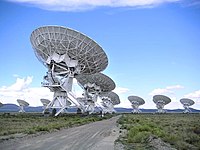
Photo from wikipedia
Although the fifth-generation (5G) networks are deployed at millimeter-wave (mmWave) frequencies, little information about the multipath clustering statistics for mmWave outdoor-to-indoor (O2I) propagation has been reported. This letter attempts to… Click to show full abstract
Although the fifth-generation (5G) networks are deployed at millimeter-wave (mmWave) frequencies, little information about the multipath clustering statistics for mmWave outdoor-to-indoor (O2I) propagation has been reported. This letter attempts to overcome this deficiency somewhat by investigating cluster-based propagation statistics for mmWave O2I that are based upon measurements. The measurements were conducted at 32 GHz at two office buildings. The multipath components (MPCs) were resolved by the space-alternating generalized expectation-maximization algorithm and the MPC clustering was performed by the K-power-means algorithm. We observed that numerous reflections bouncing back-and-forth between the windows cause large numbers of clusters. Other statistics such as the number of rays per clusters, cluster power and shadowing, cluster delay, and angular spread were also calculated.
Journal Title: IEEE Antennas and Wireless Propagation Letters
Year Published: 2021
Link to full text (if available)
Share on Social Media: Sign Up to like & get
recommendations!